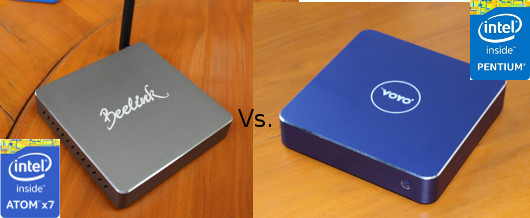Mini PCs based on Intel Apollo Lake processors have started selling, and they supposed to be upgrades to Braswell and Cherry Trail processor. I’ve recently had the chance to review Voyo VMac Mini mini PC powered by Intel Pentium N4200 quad core processor, that’s the fastest model of the Apollo Lake N series, and of course I ran some benchmarks, so I thought it would be interesting compare the results I got with an Atom x7-Z8700 “Cherry Trail” mini PC, namely Beelink BT7 which I reviewed last year.
Both machines are actively cooled with a small fan, and storage performance is similar, albeit with a slight edge for the Apollo Lake SSD. A ratio greater than one (green) means the Apollo Lake processor is faster, and if it is lower than one (red) the Cherry Trail processor win.
| Benchmark | Beelink BT7 Intel Atom x7-Z8700 @ 1.6 / 2.4 GHz (2W SDP) |
Voyo (V1) Vmac Mini Intel Pentium N4200 @ 1.1 / 2.5 GHz (6W TDP) |
Ratio |
| PCMark 8 Accelerated | |||
| Overall Score | 1,509 | 1,846 | 1.22 |
| Web Browsing – JunglePin | 0.59309 s | 0.52267 s | 1.13 |
| Web Browsing – Amazonia | 0.19451 s | 0.18459 s | 1.05 |
| Writing | 8.53975 s | 6.89837 s | 1.24 |
| Casual Gaming | 7.96 fps | 10.38 fps | 1.30 |
| Video Chat playback | 29.99 fps | 30.02 fps | 1.00 |
| Video Chat encoding | 301 ms | 196.66667 ms | 1.53 |
| Photo Editing | 0.65544 s | 0.45915 s | 1.43 |
| Passmark 8 | |||
| Passmark Rating | 846 | 1,052.1 | 1.24 |
| 3DMark | |||
| Ice Storm 1.2 | 23,999 | 23,511 | 0.98 |
| Cloud Gate 1.1 | 2,185 | 2,347 | 1.07 |
| Sky Diver 1.0 | 1,131 | 1,384 | 1.22 |
| Fire Strike | 276 | 267 | 0.97 |
The performance is usually faster in the Apollo Lake processor by between 5 to 50+% depending on the tasks with video encoding and photo editing gaining the most. Browsing is only marginally faster by 5 to 13%. PCMark8 reports a 30% higher frame rate for casual gaming, but 3DMark does not how that much improvement, and in some cases not at all, except for Sky Diver 1.0 demo. Intel Atom x7-X8700 SoC comes with a 16EU Intel HD graphics Gen 9 @ 200 / 600 MHz, while the Pentium SoC comes with 18 EU (Execution Unit) of the same gen9 GPU @ 200 / 750 MHz, and should be a little faster in theory.
So based on those results, there’s a clear – although incremental – performance improvement using Apollo Lake over Cherry Trail, but depending on the use case it may not always be noticeable in games or while browsing the web.

Jean-Luc started CNX Software in 2010 as a part-time endeavor, before quitting his job as a software engineering manager, and starting to write daily news, and reviews full time later in 2011.
Support CNX Software! Donate via cryptocurrencies, become a Patron on Patreon, or purchase goods on Amazon or Aliexpress





